I am using FFTW to create a spectrum analyzer in C++.
After applying any window function to an input signal, the output amplitude suddenly seems to scale with frequency.
Retangular Window

Exact-Blackman

Graphs are scaled logarithmically with a sampling frequency of 44100 Hz. All harmonics are generated at the same level, peaking at 0dB as seen during the rectangular case. The Exact-Blackman window was amplified by 7.35dB to attempt to makeup for processing gain.
Here is my code for generating the input table...
freq = 1378.125f;
for (int i = 0; i < FFT_LOGICAL_SIZE; i++)
{
float term = 2 * PI * i / FFT_ORDER;
for (int h = 1; freq * h < FREQ_NYQST; h+=1) // Harmonics up to Nyquist
{
fftInput[i] += sinf(freq * h * K_PI * i / K_SAMPLE_RATE); // Generate sine
fftInput[i] *= (7938 / 18608.f) - ((9240 / 18608.f) * cosf(term)) + ((1430 / 18608.f) * cosf(term * 2)); // Exact-Blackman window
}
}
fftwf_execute(fftwR2CPlan);
Increasing or decreasing the window size changes nothing. I tested with the Hamming window as well, same problem.
Here is my code for grabbing the output.
float val; // Used elsewhere
for (int i = 1; i < K_FFT_COMPLEX_BINS_NOLAST; i++) // Skips the DC and Nyquist bins
{
real = fftOutput[i][0];
complex = fftOutput[i][1];
// Grabs the values and scales based on the window size
val = sqrtf(real * real + complex * complex) / FFT_LOGICAL_SIZE_OVER_2;
val *= powf(20, 7.35f / 20); // Only applied during Exact-Blackman test
}
Curiously, I attempted the following to try to flatten out the response in the Exact-Blackman case. This scaling back down resulted in a nearly, but still not perfectly flat response. Neat, but still doesn't explain to me why this is happening.
float x = (float)(FFT_COMPLEX_BINS - i) / FFT_COMPLEX_BINS; // Linear from 0 to 1
x = log10f((x * 9) + 1.3591409f); // Now logarithmic from 0 to 1, offset by half of Euler's constant
val = sqrt(real * real + complex * complex) / (FFT_LOGICAL_SIZE_OVER_2 / x); // Division by x added to this line